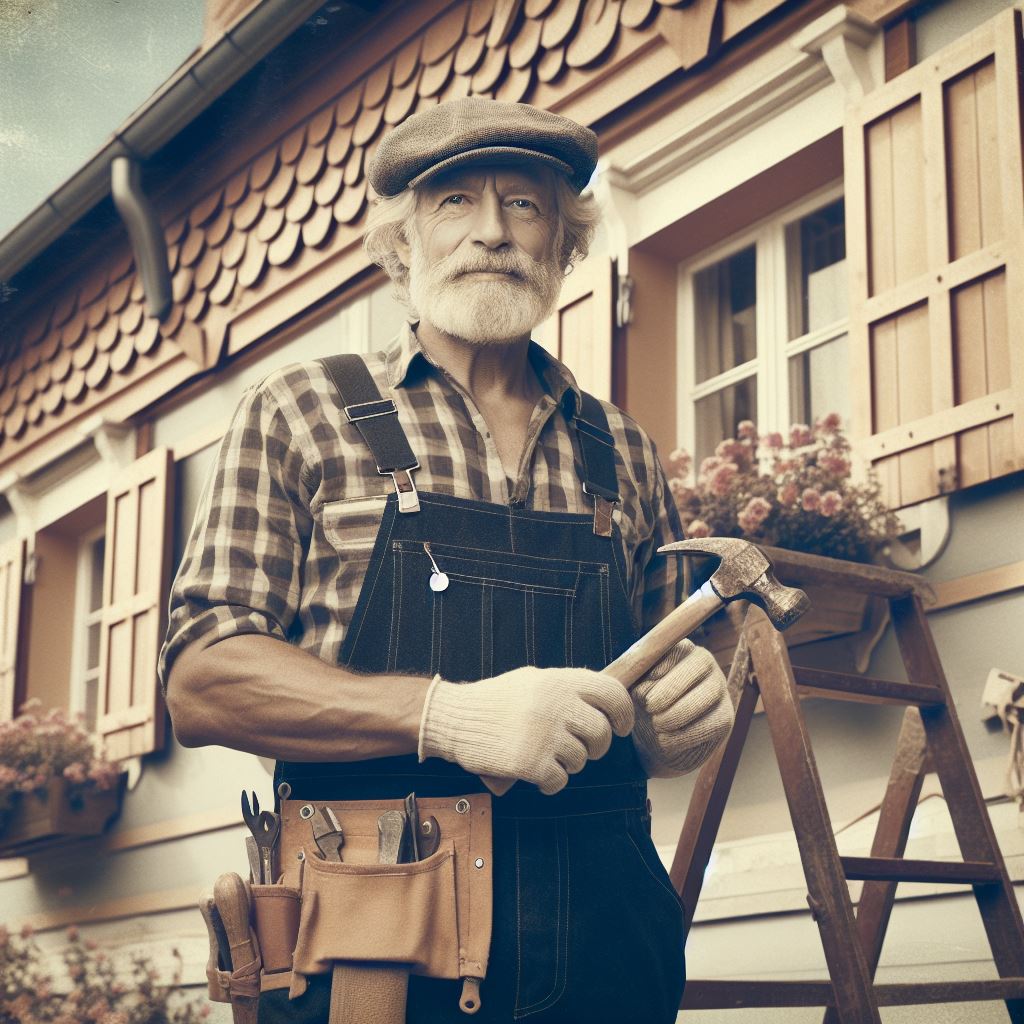Old Home Safety Checks Pre-Renovation
Last Updated on January 25, 2024
Introduction
Renovating an old home can be an exciting project, but before diving into the renovations, it is crucial to prioritize safety.
Conducting safety checks before starting any renovations is imperative to ensure a secure living environment.
An old home may have hidden dangers lurking within its walls, such as faulty electrical wiring or asbestos-containing materials.
These hazards can pose serious health risks to the occupants if not identified and addressed beforehand.
Therefore, it is essential to thoroughly inspect the house and identify potential safety hazards.
The purpose of this blog post is to emphasize the significance of conducting safety checks before renovating an old home.
By doing so, homeowners can mitigate the risks associated with renovation work and create a safe environment for themselves and their families.
Inspecting the electrical system is a critical first step, addressing any exposed wiring or outdated fixtures.
It is also essential to check for any signs of water damage, which can lead to mold growth or weakened structural integrity.
Furthermore, old homes may contain hazardous materials such as lead-based paint or asbestos.
Identifying and safely removing these materials is crucial to prevent health complications.
Testing for air quality is also recommended to ensure the presence of radon gas or other harmful substances.
In essence, safety checks before renovating an old home are of utmost importance.
This blog post aims to educate homeowners on the significance of conducting thorough inspections to ensure a safe living environment for themselves and their families.
By prioritizing safety, homeowners can enjoy the renovation process with peace of mind.
Assessing the Structural Integrity
A crucial step in conducting safety checks before renovating an old home is to assess its structural integrity.
This involves inspecting various components of the home to ensure they are stable and in good condition.
Inspecting the foundation for cracks or movement
The foundation is the backbone of any structure, and it’s essential to evaluate its condition before initiating any renovations.
Look for visible cracks or signs of movement, which may indicate potential structural issues.
Check for unevenness in floor levels, sticking doors or windows, or gaps between walls and floors.
These signs may suggest a compromised foundation that needs immediate attention from a professional.
Checking the condition of load-bearing walls and columns
Load-bearing walls and columns play a crucial role in supporting the weight of the entire structure, and their condition should be carefully assessed.
Look out for signs of decay, water damage, or insect infestation.
Examine the walls and columns for any visible cracks or bowing.
These issues may compromise the structural integrity of the home, and a structural engineer should be consulted to address them properly.
Ensuring the roof is stable and in good condition
The roof protects the entire home from external elements and must be evaluated for stability and overall condition.
Inspect for loose or damaged shingles, sagging areas, or signs of water leaks.
Check for any visible signs of mold or rot, as these can indicate underlying issues that need immediate attention.
A professional roofing contractor can provide recommendations for repairs or replacements, if necessary.
Examining the condition of the flooring and stairs
The flooring and stairs are frequently used areas of a home and should be examined to ensure they are safe and in good condition.
Look for loose floorboards, uneven steps, or signs of wear and tear.
Inspect for any signs of water damage, such as stains or discoloration.
These issues may require repairs or replacements to prevent accidents and ensure the overall safety of the home.
By thoroughly assessing the structural integrity of an old home before renovation, you can identify and address potential safety hazards.
Consulting professionals, such as structural engineers and roofing contractors, will help ensure that any necessary repairs are performed correctly.
Remember, safety should always be a priority when undertaking home renovations, and these checks will provide a solid foundation for a successful and secure remodeling project.
Read: Historic Window Restoration Techniques
Electrical System Evaluation
Important steps to take to ensure the electrical system is up to code and safe
A safe electrical system is crucial for any old home, especially before starting renovations.
Here are some important steps to take to ensure the electrical system is up to code and safe:
- Hiring a licensed electrician for a thorough inspection: It is essential to hire a licensed electrician who specializes in old homes to perform a comprehensive evaluation of the electrical system.
They have the expertise to identify potential hazards and provide solutions. - Identifying outdated or faulty wiring: The electrician will check the entire electrical system, including wiring, to identify any outdated or faulty components.
This could include outdated knob-and-tube wiring or aluminum wiring prone to overheating. - Checking the service panel and circuit breakers: The service panel and circuit breakers should be inspected for any issues.
The electrician will ensure they are functioning properly, properly sized, and labeled correctly. Upgrading to modern circuit breakers may be recommended. - Assessing the condition of outlets, switches, and light fixtures: The electrician will inspect all outlets, switches, and light fixtures for signs of wear or damage.
This includes checking for loose connections or exposed wiring, which could pose a fire hazard.
Additional tips to ensure electrical safety in an old home
By conducting a thorough evaluation of the electrical system, you can identify potential safety concerns and take appropriate measures to address them before any renovations take place.
Here are some additional tips to ensure electrical safety in an old home:
- Ground Fault Circuit Interrupters (GFCIs): Install GFCIs in areas where water is present, such as bathrooms, kitchens, and outdoor outlets.
GFCIs protect against electric shock by shutting off power if a ground fault occurs. - Arc Fault Circuit Interrupters (AFCIs): AFCIs protect against electrical fires caused by arcing faults.
Consider upgrading the electrical system to include AFCIs, particularly in bedrooms and living areas. - Regular Inspections: Schedule regular inspections by a licensed electrician to ensure the electrical system remains safe and up to code.
This is especially important in older homes with outdated wiring. - Proper Overloading: Avoid overloading electrical circuits by using power strips and extension cords responsibly.
- Update Outlets: If your old home has two-prong outlets, consider updating them to three-prong grounded outlets to provide a safer electrical connection and accommodate modern appliances.
- Proper Light Bulbs: Use the correct wattage light bulbs in fixtures to prevent overheating and potential fire hazards.
- Repair Damaged Wiring: If you notice damaged or frayed wiring, have it repaired promptly to prevent electrical hazards.
Remember, electricity is a vital part of our daily lives, but it can also pose serious risks.
Taking the necessary precautions and conducting thorough electrical system evaluations are essential, especially in old homes.
Make sure to consult with a licensed electrician and follow their advice to ensure your old home’s electrical system is safe and meets current standards before starting any renovations.
Read: Renovation Tax Credits for Historic Homes
Plumbing and Water Supply Examination
Inspecting the water heater for leaks or corrosion
Prior to beginning any renovation project, it is crucial to conduct a thorough inspection of the plumbing and water supply in your old home.
One of the primary areas to examine is the water heater. Make sure to check for any signs of leaks or corrosion.
A small leak can quickly escalate into a major problem if left unaddressed.
Corrosion, on the other hand, can compromise the integrity of the heater and lead to potential failures or malfunctions.
Therefore, it is essential to take immediate action if any issues are detected during the inspection.
Checking for pipe leaks or damage
Another important aspect of your pre-renovation plumbing inspection is checking for pipe leaks or damage.
Leaky pipes can cause significant water damage to your old home and lead to mold growth.
Inspect all visible pipes, paying close attention to joints and connections, as they are common areas for leaks to occur.
Furthermore, examine the walls, ceilings, and floors for any signs of water stains, discoloration, or moisture.
If any damage or leaks are found, it is recommended to hire a professional plumber to fix the issues before proceeding with the renovation.
Assessing the condition of the septic or sewer system
The septic or sewer system is an often overlooked yet vital component of a home’s plumbing.
Before starting any renovation work, it is essential to assess the condition of the septic or sewer system in your old home.
Inspect the tank for signs of cracks, leaks, or odors. If your property is connected to a public sewer system, check the sewer lines for any blockages or obstructions.
It is highly advisable to have a professional inspection performed, as they can accurately assess the condition and functionality of the system and recommend any necessary repairs or maintenance.
Testing the water pressure and flow
Lastly, it is crucial to test the water pressure and flow in your old home before renovating.
Inadequate water pressure can be a nuisance, making daily tasks like showering or washing dishes frustrating.
To check the water pressure, attach a pressure gauge to a faucet and turn it on. Ideally, the pressure should be between 40 and 80 pounds per square inch (psi).
Additionally, test the water flow by turning on multiple faucets or appliances at once to evaluate if it can handle the anticipated demand during the renovation.
If any issues are identified, consult a professional plumber to determine the cause and recommend the appropriate solutions.
By conducting a comprehensive examination of your old home’s plumbing and water supply, you can identify any potential issues that may arise during the renovation process.
Addressing these problems before starting the project will not only ensure the safety of your home but also prevent further damage and costly repairs in the future.
Remember, it is always better to be proactive and make necessary repairs upfront rather than dealing with the consequences later on.
Read: Old House Insulation: Best Practices

HVAC System Review
A proper assessment of the HVAC system is crucial for ensuring the safety and efficiency of an old home before renovation.
Here are some important aspects to consider:
Checking the age and condition of the heating and cooling systems
Start by examining the age and overall condition of the HVAC system.
Older systems may have outdated technology, less efficiency, and a higher risk of malfunction.
Look for signs of wear and tear, such as rust, leaks, or strange noises coming from the unit.
If the system is nearing the end of its lifespan, it might be necessary to replace it entirely.
Inspecting air ducts and vents for cleanliness and proper functioning
Inspect the air ducts and vents for any blockages, dirt, or debris. Dirty vents can lead to poor indoor air quality and may even pose a fire hazard.
Ensure that the air ducts are properly sealed to prevent air leakage, which can lead to energy wastage and reduced efficiency.
Any damaged or disconnected ducts should be repaired or replaced.
Assessing the energy efficiency of the HVAC system
Determine the energy efficiency rating of the HVAC system. Older systems tend to be less efficient, contributing to higher energy bills and environmental impact.
If the system is outdated, consider upgrading to a more energy-efficient model.
Look for systems with higher SEER ratings for cooling and AFUE ratings for heating, as these indicate better efficiency.
Confirming the presence of carbon monoxide detectors and smoke alarms
Check if the old home is equipped with functioning carbon monoxide detectors and smoke alarms.
These devices are vital for early detection and protection against potential hazards.
Ensure that the detectors are properly installed in strategic locations, including near bedrooms and potential sources of carbon monoxide, such as the HVAC system or attached garage.
Regularly test the detectors and replace their batteries to guarantee optimal functionality.
Consider upgrading to interconnected detectors for better coverage and safety.
In summary, conducting a thorough review of the HVAC system in an old home before renovation is crucial.
This includes assessing the age and condition of the heating and cooling systems, inspecting air ducts and vents, evaluating energy efficiency, and confirming the presence of necessary detectors and alarms.
By addressing potential issues and ensuring the proper functioning of the HVAC system, homeowners can enhance safety, increase energy efficiency, and create a comfortable living environment in their renovated old home.
Read: Preserving Character in Home Remodels
Additional Hazard Evaluation
Testing for the presence of lead-based paint or asbestos
Before starting any renovations, it is crucial to test for the presence of lead-based paint and asbestos in your old home.
These hazardous materials can pose serious health risks, especially when disturbed during renovation activities.
Lead-based paint is commonly found in homes built before 1978 and can be harmful if ingested or inhaled.
Professionals can conduct tests to determine if lead-based paint is present on your walls, windows, or doors.
Similarly, asbestos is often found in old homes, especially in insulation, roofing materials, or vinyl floors.
Inhaling asbestos fibers can lead to serious respiratory diseases. Therefore, it is essential to hire a qualified professional for asbestos testing.
Checking for the existence of mold or moisture issues
An old home can be vulnerable to mold growth and moisture issues, which can lead to respiratory problems and structural damage.
It is crucial to assess the presence of mold or excessive moisture before starting any renovations.
Inspect your home for visible signs of mold, such as discoloration, musty odors, or water stains.
Additionally, consider hiring a professional mold inspector for a comprehensive evaluation, especially if you suspect hidden mold behind walls or under flooring.
Addressing moisture issues, such as leaks or inadequate ventilation, is equally important. Look for signs of water damage, dampness, or condensation.
Proper moisture control is essential to prevent mold growth and ensure a safe living environment.
Assessing the presence of radon gas
Radon gas is a radioactive gas that can seep into your home through cracks in the foundation or walls.
Prolonged exposure to high levels of radon can increase the risk of lung cancer. Therefore, it is crucial to assess the presence of radon before renovations.
You can purchase radon testing kits or hire a qualified professional to measure radon levels in your home.
If high levels of radon are detected, mitigation measures can be implemented to reduce exposure and maintain a safe living space.
Investigating the possibility of pests or insect infestations
Old homes may harbor pests and insect infestations, which can compromise safety and potentially damage the structure.
Before renovating, it is important to investigate the possibility of these unwanted guests.
Look for signs of pest activity, such as droppings, gnaw marks, or damaged materials.
Common pests found in old homes include termites, rodents, cockroaches, and bed bugs.
If necessary, consult with a pest control professional for a thorough inspection and effective treatment plan.
Eliminating pests and preventing further infestations will not only ensure a safe living environment but also protect your investment in the long run.
By conducting additional hazard evaluations, such as testing for lead-based paint or asbestos, checking for mold or moisture issues, assessing radon gas levels, and investigating pests or insect infestations, you can identify potential risks and take appropriate measures to ensure the safety of your old home before renovation.
Conclusion
In the realm of home renovations, the significance of conducting thorough safety checks in older homes cannot be overstated.
Uncover potential hazards, whether they lurk in aging electrical systems, compromised structural elements, or unseen environmental factors.
The very essence of a secure and successful renovation lies in the meticulous identification and rectification of these potential threats.
It’s not just about aesthetics; it’s about establishing a solid foundation for transformation.
Safety must reign supreme throughout the renovation process. In the hustle and bustle of remodeling, it’s easy to overlook the importance of a vigilant approach.
Yet, accidents are not mere inevitable outcomes but preventable incidents.
Elevate your awareness, prioritize safety measures, and make them an integral part of your renovation blueprint.
The beauty of your revamped living space should not come at the expense of your well-being.
For those seeking a comprehensive safety net, enlist the expertise of professionals.
Electricians, structural engineers, and environmental specialists are your allies in ensuring a seamless renovation journey.
Don’t hesitate to tap into their knowledge and experience.
Beyond the DIY spirit, professional services offer a layer of assurance, transforming your renovation into a secure and stress-free endeavor.
The success of a renovation transcends the superficial allure of a revamped space. It hinges on the proactive identification and mitigation of potential risks.
Prioritize safety, integrate it into every facet of your renovation strategy, and let the transformation be a testament not only to aesthetic prowess but also to a commitment to well-being.


